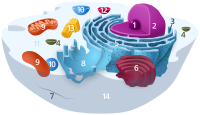
Photo from wikipedia
Fish possess a powerful IFN system to defend against aquatic virus infections. Nevertheless, spring viremia of carp virus (SVCV) causes large-scale mortality in common carp and significant economic losses to… Click to show full abstract
Fish possess a powerful IFN system to defend against aquatic virus infections. Nevertheless, spring viremia of carp virus (SVCV) causes large-scale mortality in common carp and significant economic losses to aquaculture. Therefore, it is necessary to investigate the strategies used by SVCV to escape the IFN response. In this study, we show that the SVCV nucleoprotein (N protein) negatively regulates cellular IFN production by degrading stimulator of IFN genes (STING) via the autophagy-lysosome-dependent pathway. First, overexpression of N protein inhibited the IFN promoter activation induced by polyinosinic-polycytidylic acid and STING. Second, the N protein associated with STING and experiments using a dominant-negative STING mutant demonstrated that the N-terminal transmembrane domains of STING were indispensable for this interaction. Then, the N protein degraded STING in a dose-dependent and autophagy-lysosome-dependent manner. Intriguingly, in the absence of STING, individual N proteins could not elicit host autophagic flow. Furthermore, the autophagy factor Beclin1 was found to interact with the N protein to attenuate N protein-mediated STING degradation after beclin1 knockdown. Finally, the N protein remarkably weakened STING-enhanced cellular antiviral responses. These findings reveal that SVCV uses the host autophagic process to achieve immune escape, thus broadening our understanding of aquatic virus pathogenesis.
Journal Title: Journal of immunology
Year Published: 2022
Link to full text (if available)
Share on Social Media: Sign Up to like & get
recommendations!